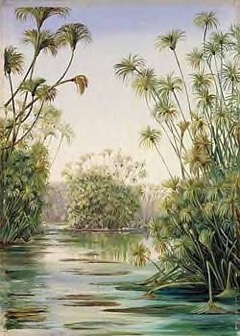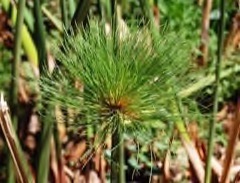 |
|
edibleplants.org |
 |
| wikimedia.org tato grasso |
Translate this page:
Summary
Physical Characteristics

 Cyperus papyrus is an evergreen Perennial growing to 5 m (16ft) by 0.3 m (1ft in) at a fast rate.
Cyperus papyrus is an evergreen Perennial growing to 5 m (16ft) by 0.3 m (1ft in) at a fast rate.
See above for USDA hardiness. It is hardy to UK zone 10.
Suitable for: light (sandy), medium (loamy) and heavy (clay) soils. Suitable pH: mildly acid, neutral and basic (mildly alkaline) soils. It cannot grow in the shade. It prefers wet soil and can grow in water.
UK Hardiness Map
US Hardiness Map
Synonyms
Chlorocyperus papyrus (L.) Rikli Cyperus antiquorum (Willd.) Chiov. Cyperus elapses Chiov. Cyperus imerinensis Boeckeler Cyperus madagascariensis (Willd.) Roem. & Schult. Cyperus nyassicus Chiov. Cyperus panormitanus Chiov. Cyperus papyraceus Crantz Cyperus siculus Chiov. Cyperus syriacus Parl. Cyperus ugandensis Chiov. Cyperus zairensis Chiov. Papyrus antiquorum Willd. Papyrus domesticus Poir. Papyrus madagascariensis Willd. Papyrus mossambicensis Parl. Papyrus siculus Parl.
Plant Habitats
Edible Uses
Edible Parts: Root Stem
Edible Uses:
The pith of the stem was recommended for food in ancient Egypt[269 ]. Rhizomes and lowermost parts of the stems - raw or cooked[269 ]. They can also be chewed, sucked, and spat out, much as sugar cane is done[269 ].
References More on Edible Uses
Medicinal Uses
Plants For A Future can not take any responsibility for any adverse effects from the use of plants. Always seek advice from a professional before using a plant medicinally.
Papyrus had a number of medicinal applications in the past, though it is little, if at all, used nowadays[269 ]. The pith was recommended for widening and drying of fistula[269 ]. The main use seems to have been confined to burnt papyrus sheets, the ash of which was reputed to have the action of pulverised charcoal and was used in the treatment of certain eye diseases[269 ]. The ash was also said to check malignant ulcers from spreading in the mouth or elsewhere[269 ]. It was also said that, if macerated in vinegar and then burnt, the ash would heal wounds[269 ].
References More on Medicinal Uses
The Bookshop: Edible Plant Books
Our Latest books on Perennial Plants For Food Forests and Permaculture Gardens in paperback or digital formats.

Edible Tropical Plants
Food Forest Plants for Hotter Conditions: 250+ Plants For Tropical Food Forests & Permaculture Gardens.
More

Edible Temperate Plants
Plants for Your Food Forest: 500 Plants for Temperate Food Forests & Permaculture Gardens.
More

More Books
PFAF have eight books available in paperback and digital formats. Browse the shop for more information.
Shop Now
Other Uses
The fibrous pith of the stems has been utilized for making paper[302 ]. For making paper, the fibrous covering is stripped off the stem and the inner pith is split into wafer-like strips. These strips are then laid side by side, with others placed crosswise on top; the strips are dampened then pressed so that their glue-like sap cements them together. They are then dried into a sheet[269 ].. The plant was also traditionally used to make formal bouquets funeral garlands, boats, cordage, fans, sandals, matting, corkage, boxes, and paper[269 ]. Papyrus stems can be used for caulking seams in wooden ships[269 ]. Papyrus mats are used for making fences and huts[269 ]. The rhizomes are cut into sections and used as beads[520 ].
Special Uses
Carbon Farming
References More on Other Uses
Cultivation details
Historic Crop Industrial Crop: Biomass Management: Hay Regional Crop
A plant of the subtropics to the tropics. It can tolerate a mean annual precipitation in the range 100 - 4,200mm, and a mean annual temperatures of 20 - 30?c[269 ]. Succeeds in full sun and in partial shade[200 , 302 , 352 ]. Prefers a fertile, wet soil, or shallow water up to 30cm deep[200 , 302 ]. The plant can tolerate a pH in the range 6.0 - 8.5[269 ]. Plants can spread rapidly by means of their rhizomes[302 ]. Many African swamps are dominated by papyrus thickets, which totally block navigation. It is estimated that the swamp areas of the White Nile, and the 'Papyrus Swamps' around Lake Kioga and Victoria are responsible for the loss of 50% of that river's water through evaporation and plant transpiration[269 ]. Plants can flower throughout the year[269 ].
Carbon Farming
-
Historic Crop
These crops were once cultivated but have been abandoned. The reasons for abandonment may include colonization, genocide, market pressures, the arrival of superior crops from elsewhere, and so forth.
-
Industrial Crop: Biomass
Three broad categories: bamboos, resprouting woody plants, and giant grasses. uses include: protein, materials (paper, building materials, fibers, biochar etc.), chemicals (biobased chemicals), energy - biofuels
-
Management: Hay
Cut to the ground and harvested annually. Non-destructive management systems maintaining the soil organic carbon.
-
Regional Crop
These crops have been domesticated and cultivated regionally but have not been adopted elsewhere and are typically not traded globally, Examples in this broad category include perennial cottons and many nuts and staple fruits.
References Carbon Farming Information and Carbon Sequestration Information
Temperature Converter
Type a value in the Celsius field to convert the value to Fahrenheit:
Fahrenheit:
The PFAF Bookshop
Plants For A Future have a number of books available in paperback and digital form. Book titles include Edible Plants, Edible Perennials, Edible Trees,Edible Shrubs, Woodland Gardening, and Temperate Food Forest Plants. Our new book is Food Forest Plants For Hotter Conditions (Tropical and Sub-Tropical).
Shop Now
Plant Propagation
Seed - Division.
Other Names
If available other names are mentioned here
Paper-rush, Paper-reed, Papirus, Uloko, Umufuunzo, Papyrus sedge, Indian matting plant, Nile grass
Native Range
AFRICA: Egypt, Ethiopia, Sudan, Chad, Kenya, Tanzania (incl. Zanzibar), Uganda, Burundi, Democratic Republic of the Congo, Congo, Gabon, Rwanda, Benin, Côte D‘Ivoire, Guinea, Liberia, Nigeria, Senegal, Angola, Mozambique, Malawi, Zambia, Botswana, Namibia, South Africa (KwaZulu-Natal, Limpopo, Mpumalanga), Madagascar, Mauritius, Reunion
Weed Potential
Right plant wrong place. We are currently updating this section.
Please note that a plant may be invasive in one area but may not in your area so it's worth checking.
Considered a weed in the Sudan, Dahomey and Egypt[269 ].
Conservation Status
IUCN Red List of Threatened Plants Status : Status: Least Concern

| Related Plants
|
| Latin Name | Common Name | Habit | Height | Hardiness | Growth | Soil | Shade | Moisture | Edible | Medicinal | Other |
| Cyperus aristatus | Bearded nutsedge | Perennial | 1.5 |
5-10
| | LM | N | MWe | 2 | 0 | 2 |
| Cyperus articulatus | Jointed flatsedge, Priprioca, Piripiri | Perennial | 1.8 |
10-12
| F | LMH | N | MWeWa | 1 | 4 | 2 |
| Cyperus cephalotes | Bhada, Flat Sedges, Nut Sedges or Umbrella Sedge. | Perennial | 0.3 |
10-12
| F | LMH | N | WeWa | 0 | 1 | 2 |
| Cyperus distans | Slender Cyperus, Piedmont flatsedge | Perennial | 0.5 |
0-0
| | LM | N | MWe | 1 | 1 | 2 |
| Cyperus esculentus | Tiger Nut, Yellow nutsedge, Nut Grass | Perennial | 0.9 |
8-10
| F | LMH | N | MWe | 4 | 2 | 3 |
| Cyperus fendlerianus | Fendler's Flatsedge | Perennial | 1.5 |
-
| | LM | N | MWe | 2 | 0 | 2 |
| Cyperus giganteus | Piripiri, Mexican Papyrus | Perennial | 1.5 |
9-11
| F | LMH | N | WeWa | 0 | 2 | 3 |
| Cyperus longus | Galingale | Perennial | 1.2 |
6-9
| F | LMH | N | MWeWa | 2 | 1 | 3 |
| Cyperus rotundus | Nut Grass | Perennial | 0.6 |
0-0
| | LM | N | MWe | 3 | 3 | 2 |
| Cyperus schweinitzii | Flatsedge, Schweinitz's flatsedge | Perennial | 0.8 |
0-0
| | LM | N | MWe | 2 | 0 | 2 |
| Cyperus setigerus | Lean flatsedge | Perennial | 1.0 |
0-0
| | LM | N | MWe | 2 | 0 | 2 |
| Cyperus tegetiformis | | Perennial | 0.0 |
-
| | LM | N | MWe | 0 | 0 | 2 |
| Cyperus textilis | Flat sedge, Basket grass, | Perennial | 1.5 |
9-12
| F | LMH | FSN | MWeWa | 0 | 0 | 4 |
| Cyperus ustulatus | | Perennial | 1.2 |
-
| | LM | N | MWe | 0 | 0 | 2 |
|
Growth: S = slow M = medium F = fast. Soil: L = light (sandy) M = medium H = heavy (clay). pH: A = acid N = neutral B = basic (alkaline). Shade: F = full shade S = semi-shade N = no shade. Moisture: D = dry M = Moist We = wet Wa = water.
Now available:
Food Forest Plants for Mediterranean Conditions
350+ Perennial Plants For Mediterranean and Drier Food Forests and Permaculture Gardens.
[Paperback and eBook]
This is the third in Plants For A Future's series of plant guides for food forests tailored to
specific climate zones. Following volumes on temperate and tropical ecosystems, this book focuses
on species suited to Mediterranean conditions—regions with hot, dry summers and cool, wet winters,
often facing the added challenge of climate change.
Read More
Expert comment
Author
L.
Botanical References
Links / References
For a list of references used on this page please go here
A special thanks to Ken Fern for some of the information used on this page.
Readers comment
| Add a comment |
|
If you have important information about this plant that may help other users please add a comment or link below. Only comments or links that are felt to be directly relevant to a plant will be included. If you think a comment/link or information contained on this page is inaccurate or misleading we would welcome your feedback at [email protected]. If you have questions about a plant please use the Forum on this website as we do not have the resources to answer questions ourselves.
* Please note: the comments by website users are not necessarily those held by PFAF and may give misleading or inaccurate information.
To leave a comment please Register or login here All comments need to be approved so will not appear immediately.
|
Subject : Cyperus papyrus
|
|
|
|